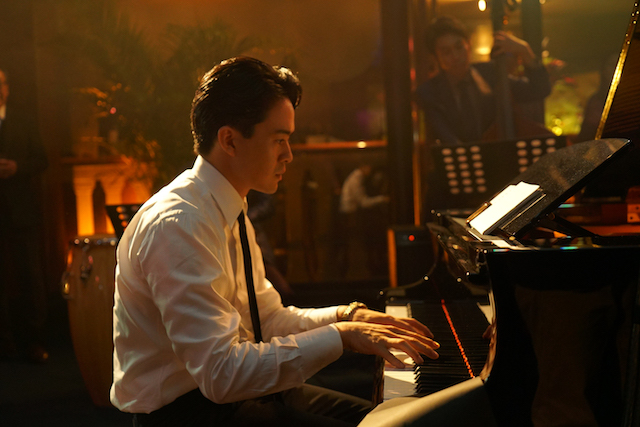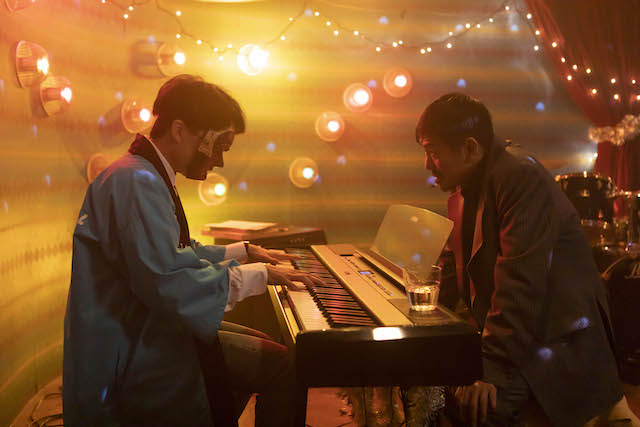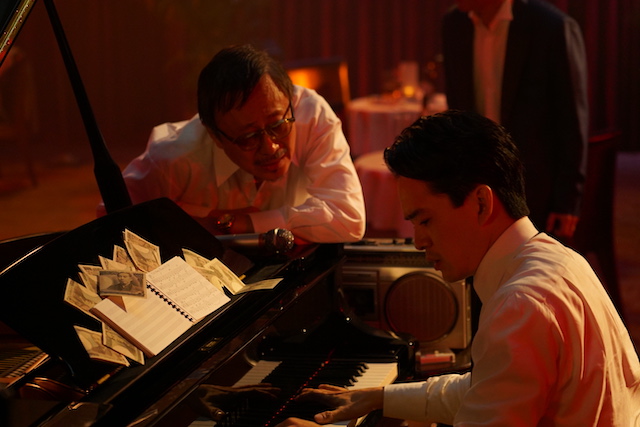
©Courtesy of Japan Cuts
Between the White Key and the Black Key :Music sweeps through 1980s Ginza, a glamorous and dangerous neighborhood where well heeled Tokyoites, artists and thugs all sway together under the power of jazz. Sosuke Ikematsu stars in this spiraling, splintering, intersecting Mobius strip of a film based on the memoirs of jazz pianist Hiroshi Minami and a single night and a forbidden song that changes destiny. Also featuring Japanese pop star Crystal Kay.
Director : Masanori Tominaga
Running Time : 94 min.
Original Language : Japanese with English subtitles.
Cast : Sosuke Ikematsu, Riisa Naka, Go Morita, Crystal Kay.

©Courtesy of Japan Cuts
Exclusive Interview with Director Masanori Tominaga
Q: You directed a film that was centered around the memoirs of Japanese jazz pianist Hiroshi Minami. What was your favorite aspect of the original work that prompted you to make the film?
Masanori Tominaga: There are actually several reasons, but one is that I am a jazz fan, which was already the biggest reason. I met Minami-san a little over ten years ago, At that time I was filming a concert of jazz musicians in Tokyo in parallel with the production of the movie.
I held many such jobs, but one of them involved working with Shigeyoshi Kikuchi, who has provided music for many of my films, and I came to know Minami through him. I had just completed reading the book that this movie is based on, which had just been published.
Even though we had never met before, we started talking about creating a video around 12 or 13 years ago. The book describes Mr. Minami’s carefree or complicated feelings towards music while he was young, and he believed that there was no place in Tokyo where he could perform the type of radical jazz music he desired. Of course, he was not yet talented because he was young at that time. He was working where he could maximize his earnings, with that in mind.
Not only young jazz musicians, but young filmmakers—anyone who wants to express something—can relate to the story. I thought that there were two reasons for this, and I thought that there would be people who would watch this. The other reason, which I realized later, was that Tokyo in the 1980s was crazy.
I thought it would be better to remember now what it was like to live in a Tokyo back then, as you compare “not crazy” Tokyo because of lack of money now. Even though there are only a few people who still have money in Tokyo, I believe it’s best to remember something like that now.
Q: The cabarets shown in this film are described as having dancers, actors, painters, and poets, just like the cabarets found in New York and France. What was the atmosphere like at a cabaret during the Showa era? Have you conducted any research?
Masanori Tominaga: With the cabarets in New York or Paris, there was an aspect of [Tokyo] being a cultural center, wasn’t there? Actually, to tell the truth, I didn’t study that. That’s usually well-known, even if you don’t study it that much. For example, I think there are lots of stories about how Taro Okamoto met Picasso at a cabaret in Paris. How about cabarets in Japan?
The cabaret was just a name, and it was a place where you could savor drinks and converse with female “social workers” (up until the 1964 Tokyo Olympics, these were female workers who worked in bars, clubs, and cabarets, but are now termed hostesses).
Well, in the 60’s, there was a grand cabaret in Tokyo and Osaka, not so much a cabaret, but a grand cabaret. There were even larger cabarets, and Nat King Cole used to come to Japan and give concerts there.
Q: Really, did that happen?
Masanori Tominaga: Only in a very limited number of places. I think the famous New Latin Quarter and other places like that were exceptional, but those places were visited by politicians. I don’t know if it’s true or not, but I heard that CIA spies also came to those places.
Q: I see, so there are many anecdotes about the cabarets themselves.
Masanori Tominaga: There are numerous books available on the subject, many of which are non-fiction books about the underground romance of the Showa era nightlife, but I found them to be irrelevant to this film and found things to be less glamorous.
Q: I see. So now Mr. Ikematsu is playing two roles, one as Minami and the other as Hiroshi, and I thought that was a very interesting approach. Well, of course, I think Mr. Ikematsu’s acting ability was a factor, but how did you come up with the idea of giving him the two roles? Or was that already in Minami’s memoirs, and that’s how you came up with the idea?
Masanori Tominaga: Yes, that’s correct, In the book, Mr. Minami recounts his experience playing the piano between two stores for three years. My predecessor played the piano in the same way for three years before I became the one.
And when he quits, when his successor is assigned to play the piano in his place, there has to be a pianist playing in that restaurant every night for sure. The cycle lasted for three years, and there was a pianist before and after him, and I wanted to portray this in the movie.
In other words, I wanted to portray both my predecessor as myself and my successor as myself–in this case, Ikematsu When I did this, and this is another reason, the book describes the events of the three years, when he started playing piano at the Ginza store and when he was thinking about how to quit this store, in other words, the first day and the last day of the three years. So I divided them into two positions, the predecessor and the successor, and forced them into one night. I guess you can say it’s a bit of a two-for-one thing. I pondered the idea of having one person play two roles and covering 33 years in one evening, giving the main character three years prior and three years afterwards.

©Courtesy of Japan Cuts
Q: The music from The Godfather film is used in the movie, and in Japan, it is played by motorcycle gangs. Do you have any fond memories of Godfather songs?
Masanori Tominaga: (I like the music of composer Nino Rota, and I like The Godfather movie, but I don’t have such a strong attachment to the music of The Godfather movie (“Theme of Love”) itself.
Well, it’s too famous, not that there is anything special about it. But that “Godfather Love Theme” is played in Part 1, but not after Part 2, right? Part 2 is much darker. Nino Rota and Carmine Coppola were also working on it, and it was more like contemporary music, darker and more difficult.
Q: How did you cast some real musicians like the saxophone player Kei Matsumaru and the singer Crystal Kay?
Masanori Tominaga: I chose these two musicians based on the idea that they were people who specialized in performance, saxophone for saxophone, singing for singing, and that they are top-notch people whom I admire and respect. Matsumaru-kun is also a graduate of Berkeley College of Music, and he is an amazing person! And I had seen him play a few times, so I talked to him right away and told him to make an appearance.
Q: But he (Matsumaru) didn’t turn them down because he had never acted before? Was he okay with that?
Masanori Tominaga: I spoke to him right after this concert, well, he was in a good mood (Lol). On the contrary, I was already thinking about Crystal-san, that there is no one else in Tokyo who has a voice like that or has that kind of expressive power except for Crystal-san.
The jazz musician from the U.S. plays an excellent role, and his rendition of an old blues song with dark lyrics is captivating. Crystal’s expressiveness was a major factor in her credit for singing it.
Q: I understand that you also filmed live jazz performances, including jazz cafes, which are quite heavily influenced by jazz.
Masanori Tominaga: I probably went to jazz cafes and live music clubs more often than movie theaters.
Q: Since you are involved in the film industry, you must get a lot of inspiration from music, don’t you think?
Masanori Tominaga: I think so. I wanted to speak more with Crystal Kay about how musicians come up with their ideas, but I was too busy during the shooting to do so. I desired to inquire about her approach to interpreting popular standards when singing her own songs as a vocalist.
This is almost the same as making a movie, isn’t it? So it would have been nice to hear about that. I am influenced by musicians, especially jazz musicians, and I am also influenced by records.
Q: I heard that Mr. Ikematsu himself actually performed the Godfather’s love theme. Did you have him play it from the beginning, or did you have some kind of jazz player (as a trainer)?
Masanori Tominaga: I’d asked him to practice for six months. So, six months before that, the music director of the film was a pianist named Ami Ogaeri, and I explained to Ms. Ogaeri what kind of Godfather I wanted her to make, and I told her that although Mr. Minami’s book says it like this, I also had a plan, and I said, “I’m going to make a film about how it is written in Mr. Minami’s book, but that I had a plan too. I did ask him to repeat the melody of The Godfather’s “Theme of Love” four times.
About the third time, things start to get crazier and crazier, and by the fourth time, the music played became so exaggerated that the song itself disintegrated. At that time, the main character is being held down by his yakuza boss, but I asked him to rewrite it in a way that Ikematsu could still play it, and although he probably did not alter the melody and chords, he added a lot of chords that would not normally be included in that song, so it is no longer jazz.
Well, I told him that the song itself didn’t have to be The Godfather’s “Theme of Love,” so I asked him if he could make it sound the way it was supposed to be. I took a picture of him playing it, transcribed the score, and left it with Mr. Ikematsu and his piano teacher, and we practiced it about twice a week for six months.
Q: So he has been practicing for quite a long time.
A: Masanori Tominaga: Yes, that’s right. Six months is quite a long time.
Q: In your previous film Dynamite Graffiti, the story was told in chronological order. Is there any particular reason why you didn’t use that kind of film technique this time?
Masanori Tominaga: No, I already have the answer in the question you just asked me. It means that I did not want to repeat it. I had already done one more chronological period just before.
I already knew the joys and hardships of creating a chronological film, so I decided to do something completely different, which I did not mention earlier, but this is one of the main reasonsI wanted to do something completely opposite, to tell the story of several decades in one night. I think the style of the previous film will definitely influence the next film I make.
Q: I was personally interested in the role of that guy played by Mr. Morita, who makes some nice remarks and talks about how all people are equal under musi Were they originally written in Mr. Minami’s memoirs, or are there actually some lines that were adapted and created by you?
Masanori Tominaga: It’s a line I came up with, influenced by some of the words that appear in Minami’s book. This book is in the form of a memoir, which means it is a book about what happened. Occasionally, there are in-depth discussions about musicians and their listening environment. It’s hard to capture the words written in a book in a scene. Moreover, they were not the words of Mr. Minami at that time in 1988.
At the time of writing the book, Mr. Minami, who was almost 50 years old when he wrote it said, “I can’t put this in a scene because of the words he wrote, but there was one person who had a very clear view of things and when he said this, it wasn’t strange.”
That’s right. He was a guy who was not a yakuza, but he was a guy who had been in prison for 10 years and was a master of some kind. He had been in prison for 10 years and had become a monk. If a man with that kind of mentality were to speak out suddenly in a few words about his feelings, it could work.
Q: You are back in New York this time. Japan Cuts is the largest Japanese film festival in North America and is very well known in New York City. Do you have any words of enthusiasm about showing your own work in such a place on opening night?
Masanori Tominaga: Tominaga: Oh, yes, that makes me happy. Also, as I said before, I am a jazz fan, and New York is a jazz city, and I am sure that many New York moviegoers are more familiar with jazz than I am. I hope that people will understand that New York has its own New York jazz, and that Tokyo in the 80’s had some strange jazz as well.

©Courtesy of Japan Cuts
If you like the interview, share your thoughts below!
Check out more of Nobuhiro’s articles.
Here’s the trailer of the film.

